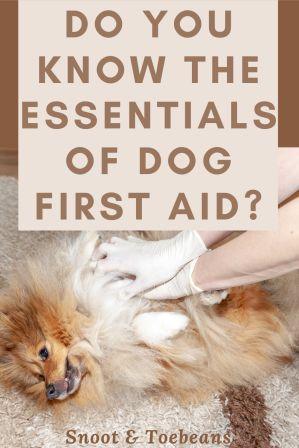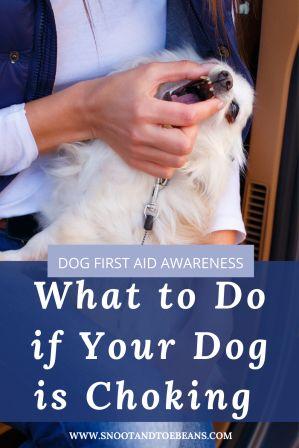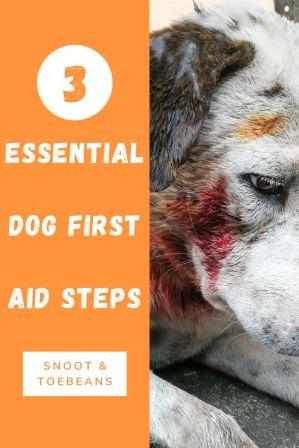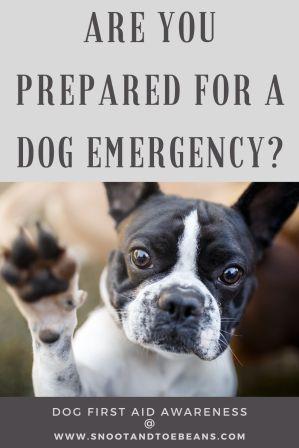Disclosure: My dog blog is supported by dog parents just like you. I only recommend products that I would use on my dogs. All opinions expressed here are my own. I sometimes earn a small affiliate commission, at no extra cost to you, when you click through the affiliate link and purchase something. You can read more about my affiliate policy here.
Do you know the essentials of dog first aid? If your dog stops breathing or goes into shock, would you know what to do?
April is National Pet First Aid Awareness Month. So, it is a great time to learn the essentials of dog first aid. Learning the essentials will help you become aware of when your doggo needs help.

In addition, it is important to understand that emergencies or accidents can happen at any time. Emergencies can look like car wrecks or run overs, bite wounds, burns, heatstroke, poisoning, seizures, and others. But, if you are prepared with some essential dog first aid, you can possibly save your doggo’s life.
Mostly, the quicker you recognize your doggo is experiencing an emergency, the quicker a veterinarian can get involved. It is important to understand that after performing dog first aid, your doggo needs to see a veterinarian.
However, before we get into the essentials, let’s delve into what dog first aid means to begin with.
What is First Aid?
Firstly, it is important to understand that first aid is the initial treatment given in any medical emergency. Consequently, this is the case whether, human or dog.
The purpose of first aid is to preserve life and reduce pain and discomfort. In addition first aid minimizes any risk of permanent disability or disfigurement.
Pet first aid involves skills that a person can do until they can get to a veterinary hospital.
Dr. Debbie Mandell, Professor, Clinical Emergency & Critical Care, University of Pennsylvania School of Veterinary Medicine
According to Mandell, the most important aspect of pet first aid is being prepared. In addition, it is important to know what is normal for your pet. So, that way, you can recognize when something is wrong.
Therefore, it is important for dog parents, sitters, and walkers, alike, to know normal things such as…
- appetite, including water consumption
- energy level
- urination and bowel habits
- sleep habits
- noises made while sleeping
- differences in barks or whimpers
In addition, it is important for these same people to know how to check a dog’s vital signs. These include gum color, breathing rate and effort, heart and/or pulse rate, and temperature.
Pets can hide signs of illness, or show subtle signs, until a disease process is fairly advanced.
Dr. Debbie Mandell, Professor, Clinical Emergency & Critical Care, University of Pennsylvania School of Veterinary Medicine
Three Essential Dog First Aid Steps
- Remain calm in the event of an emergency. Don’t panic! Therefore, you will be able to think more clearly. You will need to assess the situation determining if you or your doggo are in danger. Plus, figure out what is happening and assess for a response from your fur baby.
- Be aware of the dog first aid ABC’s and practice them once you’ve assessed the situation. The ABC’s stand for Airway, Breathing, and Circulation.
Airway
If your doggo happens to be drooling or coughing, determine if something visibly is blocking the airway. Do this by looking inside the mouth for things such as a rawhide treat or a toy.
However, never put your fingers inside an unconscious dog’s mouth.
You can try to hang your dog, head down over your shoulder or in your arms, to relieve the object.
In addition, you can gently stretch the neck and chin out away from the chest. And, try arranging the head below the throat.
Therefore, this should force the tongue to fall on the outside of the mouth. And, anything blocking the airway will hopefully fall out, too.
Breathing
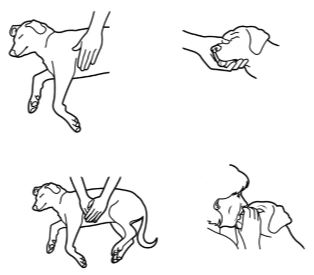
You will need to determine if your doggo is breathing and at what rate.
Their breathing could be fast, slow, not at all, or very labored. In addition, it is important to know that over 30 breaths per minute is too fast for a dog.
Next, if you’ve determined your dog is not breathing, send some air into his or her lungs. You can achieve this by creating an airtight seal around the lips and mouth with your hands.
Then, blow out of your mouth into your dog’s two nostrils while looking for the ribs to rise. After that, provide two exhalations, then give thirty chest compressions.
Circulation
Determine if your doggo has a heartbeat or pulse. Next, if you can’t hear a heartbeat, and your dog is unresponsive, begin cardiac massage.
Firstly, move your dog onto one side or the other. This can’t be done if your dog is lying on his or her front or back.
Place your dog’s spine up against something that will not move. Next, place one hand on either side of the ribs, low down near the armpit area.
Furthermore, it is important to know that the heart does not lie right in the middle of the chest. However, it lies in the lower and front end of the ribcage.
Your goal is two compressions per second, which is 120 beats per minute. Next, count to 30 and give two breaths and resume chest compressions. At each interval, listen for a spontaneous heartbeat.
- Contact your veterinarian as soon as possible if any of the ABC’s are abnormal. Keep in mind that you may not be able to provide dog first aid. And, if you are successful, you will still need to take your dog to see your veterinarian.
In Conclusion
Continue learning as much as you can about dog first aid. Therefore, keeping yourself knowledgeable will give you the confidence you will need in an emergency.
There are pet first aid and CPR courses offered by the American Red Cross and Pet Tech. In addition, you can seek information and resources from your local animal shelter. These can include, libraries, pet stores, or local veterinarians.

The Red Cross Dog and Cat First Aid online course helps pet parents determine a life-threatening emergency. In addition, emergency planning is a component of the course.
Similarly to the Red Cross course, you can download the Pet First Aid App. The app provides expert information on pet health and first aid help and planning.
Above all, remember after giving dog first aid care, you still need to make a veterinarian visit. Dog first aid should never be a substitute for veterinary care. Therefore, it is intended to stabilize your dog until you can get him or her to the veterinary clinic.
What pet first aid experiences do you have? We would love to hear all about it in the comments below.
Have you taken a dog first aid class or CPR class? Tell us about your experience in the comments below.
You might enjoy these posts from the Snoot and Toebeans’ Blog:
If you would like to save this post to your Pinterest account, you can pin one of the following images.
